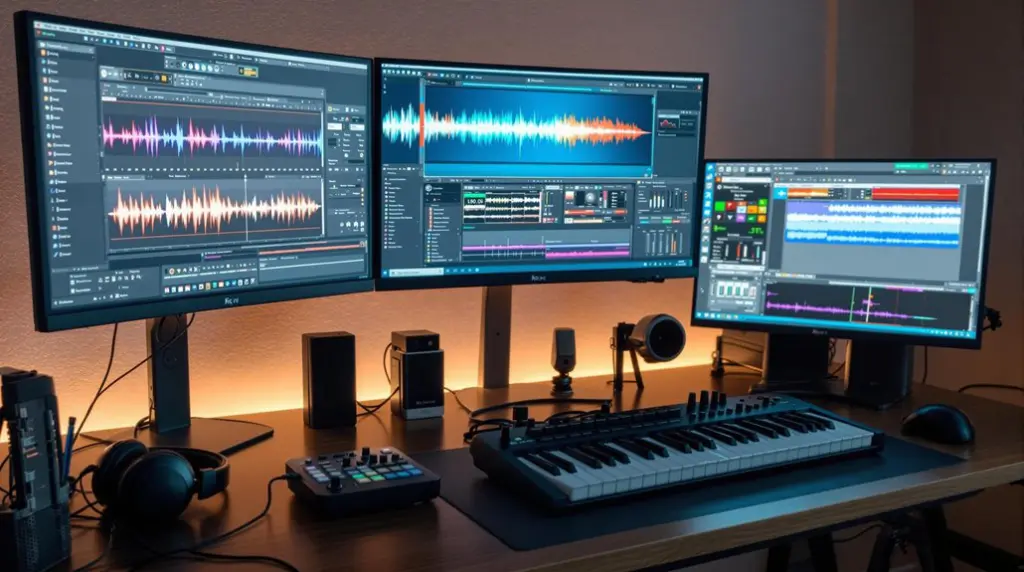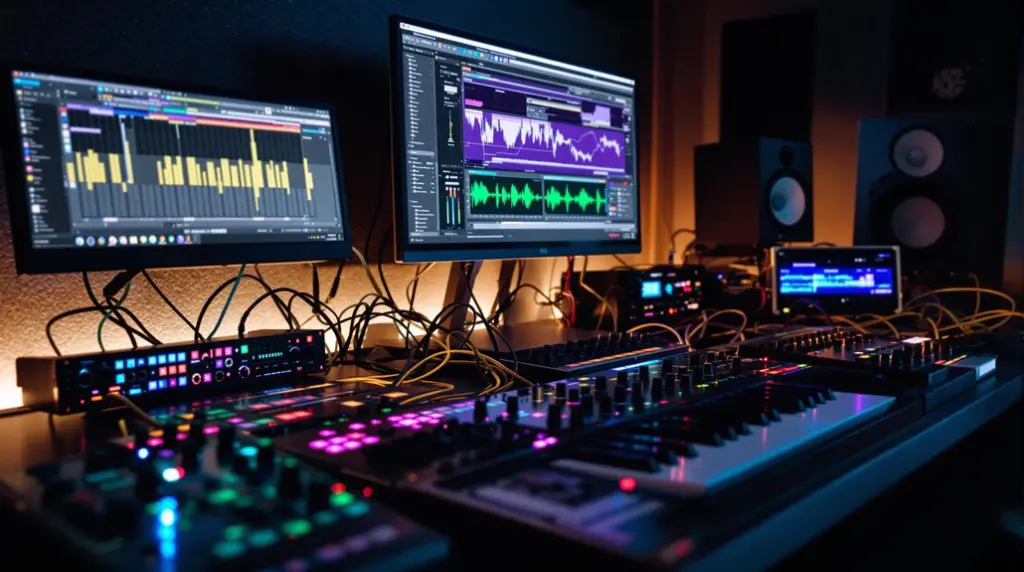In 2025, the top three headphones for music production include the Audio-Technica ATH-M50x, renowned for its effective noise isolation and robust sound profile; the Sennheiser HD 800 S, valued for its clear mid-range and balanced audio; and the Beyerdynamic DT 770 PRO, known for its comfort and warm sound signature. These models excel in providing accurate sound representation vital for mixing and mastering. Each offers features such as durability and comfortable fit, essential for extended use. Exploring further will reveal additional insights into their unique capabilities and how they enhance the music production experience.
Key Takeaways
- Audio-Technica ATH-M50x stands out for its effective noise isolation and long coiled cable, making it ideal for studio recording in 2025.
- Sony MDR-7506 remains a staple with a well-balanced sound profile and enhanced bass, perfect for professional music production.
- Beyerdynamic DT 770 PRO offers a warm sound signature and excellent comfort, suitable for extended listening sessions in studio environments.
- Sennheiser HD 800 S excels in balanced sound and audio clarity, ideal for mixing and mastering with its expansive soundstage.
- HiFiMan Edition XS provides an immersive sound experience with planar magnetic drivers at an accessible price point, making it a great choice for producers.
Best Closed-Back Headphones
When selecting headphones for music production, closed-back models are often preferred due to their superior sound isolation and ability to minimize external noise interference.
Among the best closed-back headphones, the Audio-Technica ATH-M50x stands out for its effective noise isolation and a coiled cable extending up to 10 feet, ideal for studio recording.
The Sony MDR-7506 is a staple in professional environments, offering a well-balanced sound profile with enhanced bass, despite its non-detachable cable.
Meanwhile, the Beyerdynamic DT 770 PRO provides a warm sound signature and a comfortable fit, perfect for extended sessions.
Each of these models delivers excellent sound isolation, ensuring accurate monitoring and a neutral sound profile essential for music production. Additionally, using headphones with effective noise isolation can significantly enhance your mixing and editing experience by allowing you to focus on subtle details in your audio.
Best Open-Back Headphones
Open-back headphones serve as an essential tool in music production, particularly in environments where an expansive soundstage and accurate audio representation are paramount.
The Sennheiser HD 800 S stands out as one of the best open-back headphones due to its balanced sound profile, making it ideal for mixing and mastering. Its clear mid-range and flat treble response require a powerful amplifier to realize its full potential.
The HiFiMan Edition XS offers an immersive soundstage with planar magnetic drivers, providing excellent audio quality at a more accessible price.
Meanwhile, the Beyerdynamic DT 990 PRO delivers a neutral sound and comfortable design, although its soundstage is less expansive.
Each model excels in distinct areas, catering to various production needs, and they all emphasize the importance of sound clarity in achieving high-quality audio results.
Key Features to Consider
Selecting the right headphones for music production requires careful consideration of several key features to guarantee peak performance. A flat sound profile is essential for accurate mixing and mastering, ensuring no coloration of audio products.
Comfort and fit are paramount; over-ear designs with plush padding and adjustable headbands facilitate prolonged use without discomfort, vital in professional environments. Build quality and durability should not be overlooked, as high-quality materials are necessary to withstand repetitive use and transport.
Additionally, consider the impedance; lower impedance (around 32 ohms) is ideal for direct connections, while higher impedance (over 250 ohms) may necessitate dedicated audio interfaces.
Finally, choose models with detachable cables to enhance longevity through easy replacements, further ensuring reliability in music production. A good starting point could be studio monitors for mixing that provide insight into sound accuracy, which is crucial when selecting headphones.
Frequently Asked Questions
Which Headphones Should I Use for Music Production?
For ideal music production, select studio headphones prioritizing sound isolation, flat frequency response, and audio clarity. Guarantee a comfort fit and durability features, considering budget options and brand reputation, while exploring wireless capabilities for flexibility.
Is the Headphone Industry Growing?
The headphone industry is experiencing substantial market growth driven by consumer demand for wireless options, enhanced sound quality, and noise cancellation technology. Brand competition is intensifying, reflecting evolving user preferences and emerging headphone trends in audio fidelity.
Can Headphones Last 10 Years?
Yes, headphones can achieve a ten-year lifespan, influenced by durability factors such as material wear, sound quality preservation, and maintenance tips. Brand reputation and user experiences further dictate replacement cycles, especially with technology advancements.
What Headphones Do Professional Engineers Use?
Professional engineers commonly utilize headphones that guarantee superior sound isolation, excellent frequency response, and headphone comfort. Preferences often include closed-back designs for mixing techniques, while open-back headphones enhance audio accuracy, accommodating varying brand preferences and wireless technology advancements.
Conclusion
To summarize, selecting the best headphones for music production necessitates careful consideration of specific characteristics, including sound isolation, frequency response, and comfort. The best closed-back headphones excel in sound isolation, making them suitable for tracking and mixing in untreated environments. Conversely, open-back headphones provide a more natural soundstage, ideal for critical listening and detailed mixing. Ultimately, the choice between closed-back and open-back headphones should align with the producer’s workflow and specific audio requirements.




